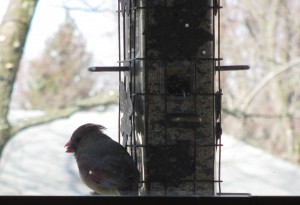I am getting a late start tonight: it is nearly 11 p.m. here. I spent the better part of the evening catching up on all the TV shows I’ve recorded over the past two weeks–probably five hours of television viewing. Now I am in my room and it is quiet: the main sound is the clacking of the keys as I type and the usual low hum from outside somewhere. I don’t know where exactly the sound comes from but it’s constant.
I am grateful this evening for the functioning of my senses. I can hear sounds all around me (even when it’s “quiet”), and not simply hear them but process the sounds and interpret what it is I’m hearing.Without actually seeing it, I know what it is. Lately I’ve been quite taken by the birdsongs in the morning. As spring gets closer to springing and the days start earlier and last longer, they are much more active, noisier earlier. Last spring and summer I discovered the dark-eyed junco by following the shrill, trilling shriek that woke me up many mornings in my condo in California. I am comfortably familiar with the various calls and whistles of the northern cardinal, now that I live back in its territory, as well as the sounds of the robins and a number of other birds in the area. My ears hear their calls first and then I go in search of them with my eyes so that I can match the call to the bird. I still haven’t spotted the little bird with the big voice, I’ve mostly heard it near my workplace, but I’m hopeful I’ll find it sometime soon.
My eyesight isn’t perfect–I’ve worn glasses for most of my life–but my eyes function well with correction. When I hear the call of a bird and my brain interprets where it’s coming from, I turn my head and scan the various trees, rooftops and wires searching for where the sound is coming from. Sometimes I am gratified by what I discover, “Ohhh, so that’s what you look like!” I say to the bird once I’ve connected the picture with the sound. I also know when birds are “fussing” at perceived predators, and recognize when the squirrels are taking umbrage with someone who has gotten too close to their abode inside the tree. I have watched them clicking and noisemaking while flicking their tails in a particular way. My sister, who studied squirrel behavior for a paper she wrote back in her undergraduate career, taught me a few things to look for when squirrels are tail flicking. I don’t remember too much about it, but it’s not rocket science to figure out that the clicking and racket in conjunction with agitated tail flicking means the squirrel is not happy.
I have been agitating the squirrels myself lately as one of them continues to go at the bird feeder. Anyone looking at my house at just the right time is liable to see me burst out the front door, running over to window where the squirrel has climbed to get to the feeder. I am shouting and “barking” at the fool creature running around the side of the house shrieking like a banshee and chasing the marauder away. (I really hope no one happened to be looking out their window at just that moment, however if they were I hope they found it as immensely entertaining as I no doubt would if I saw someone else doing it.)
I am grateful for the relatively smooth functioning of my body. My sight and hearing, my sense of smell, of taste, and touch, all sending signals to my brain which, for the most part, interprets them “correctly,” helping me to make sense of the world. I continue to be amazed by the remarkable complexity of the human body, all the millions of moving parts and processes that make up a single day in a single, individual life. It truly is miraculous. As complex as this dance of life is for a single human individual, the interconnections of the complex systems and interactions of all of life, all creatures across the entire planet is wondrously unfathomable. I will once again quote the educator and horticulturist Liberty Hyde Bailey,“It is a marvelous planet on which we ride. It is a great privilege to live thereon, to partake in the journey, and to experience its goodness.” And so it is.

